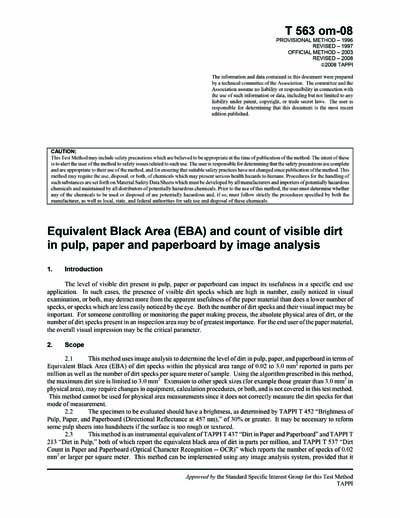Historical
T 563 om-08
Equivalent black area (EBA) and count of visible dirt in pulp, paper and paperboard by image analysis
This method uses image analysis to determine the level of dirt in pulp, paper, and paperboard in terms of Equivalent Black Area (EBA) of dirt specks within the physical area range of 0.02 to 3.0 mm reported in parts per million as well as the number of dirt specks per square meter of sample. Using the algorithm prescribed in this method, the maximum dirt size is limited to 3.0 mm Extension to other speck sizes (for example those greater than 3.0 mm in physical area), may require changes in equipment, calculation procedures, or both, and is not covered in this test method. This method cannot be used for physical area measurements since it does not correctly measure the dirt specks for that mode of measurement.
2.2 The specimen to be evaluated should have a brightness, as determined by TAPPI T 452 "Brightness of Pulp, Paper, and Paperboard (Directional Reflectance at 457 nm)," of 30% or greater. It may be necessary to reform some pulp sheets into handsheets if the surface is too rough or textured.
2.3 This method is an instrumental equivalent of TAPPI T 437 "Dirt in Paper and Paperboard" and TAPPI T 213 "Dirt in Pulp," both of which report the equivalent black area of dirt in parts per million, and TAPPI T 537 "Dirt Count in Paper and Paperboard (Optical Character Recognition -- OCR)" which reports the number of specks of 0.02 mm or larger per square meter. This method can be implemented using any image analysis system, provided that it meets the criteria specified herein.
2.4 This method, and corresponding precision statement, was developed using laboratory analyzers and cannot be considered applicable to on-line systems.
Content Provider
Technical Association of the Pulp and Paper Industry [tappi]






